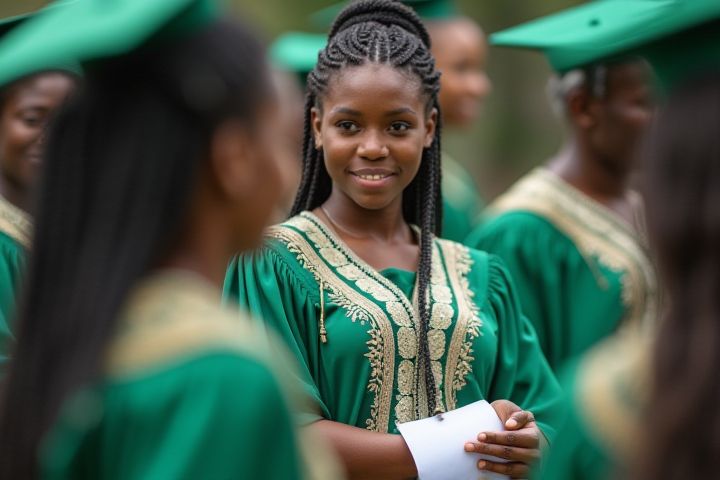
Nigeria ranks 125th out of 188 countries in the Global Education Monitoring Report by UNESCO, reflecting significant challenges in its education system. The country faces issues such as high dropout rates, inadequate infrastructure, and a shortage of qualified teachers, impacting the quality of education delivered to students. Despite increased government efforts and investment in educational reforms, disparities in access persist, particularly in rural areas compared to urban centers. The literacy rate in Nigeria stands at approximately 62%, indicating room for improvement in educational attainment across various demographics. Improving educational outcomes in Nigeria is essential for fostering economic development and empowering its youth for future success.
Nigeria's education ranking fluctuates globally.
Nigeria's education ranking varies significantly, with reports indicating a position around 125th out of 138 countries in the Global Education Index, reflecting challenges such as limited access to quality resources, inadequate infrastructure, and teacher shortages. The nation struggles with a high dropout rate and disparities in educational attainment between urban and rural areas. Factors affecting this ranking include regional conflicts, socio-economic issues, and a lack of government investment in the educational sector. For improved outcomes, Nigeria must address these systemic issues while promoting policies that enhance accessibility and quality of education for all students.
Large population impacts educational statistics.
Nigeria, with a population exceeding 200 million, faces significant challenges in its educational system, ranking 141st out of 157 countries on the Global Education Development Index. The large population strain on resources has led to overcrowded classrooms and insufficient educational infrastructure, hindering access to quality education. Additionally, high dropout rates and variations in educational attainment across regions contribute to disparities in literacy and learning outcomes. Improved investment and policies targeting these demographic challenges are crucial for enhancing Nigeria's educational landscape.
High literacy rate improvements over time.
Nigeria has made significant strides in improving its literacy rate over time, currently ranking among the countries with a growing focus on education, particularly in Africa. As of recent statistics, Nigeria's literacy rate stands at approximately 62%, reflecting efforts in expanding access to education and increasing enrollment in primary and secondary schools. Ongoing challenges such as regional disparities and funding issues persist, yet initiatives like the Universal Basic Education (UBE) program aim to enhance literacy and educational quality further. Your understanding of Nigeria's educational landscape highlights the importance of continuous reform and investment in human capital development.
Urban vs rural education quality disparity.
Nigeria's education ranking reflects significant challenges, particularly the disparity between urban and rural educational quality. In urban areas, access to quality education is bolstered by better infrastructure, trained teachers, and resources, allowing for a more conducive learning environment. Conversely, rural regions often contend with inadequate facilities, fewer qualified educators, and limited educational materials, leading to lower literacy rates and academic performance. This stark contrast underscores the urgent need for targeted policies to improve educational equity and enhance opportunities for students in rural communities.
Government initiatives for better access.
Nigeria's education system ranks low globally, often cited around 125 out of 138 countries in the World Economic Forum's Global Competitiveness Index. Government initiatives, including the National Policy on Education, emphasize improving access to quality education for all citizens. The Universal Basic Education (UBE) program mandates free and compulsory education for children aged 6 to 15, aiming to reduce enrollment disparities, especially in rural areas. You may also note the ongoing partnerships with international organizations, which focus on funding and implementing educational reforms to enhance accessibility and improve learning outcomes across the nation.
Various challenges affecting quality.
Nigeria currently ranks low in global education indices, primarily due to challenges such as inadequate funding, poorly trained teachers, and a lack of infrastructure. The ongoing issues of corruption and mismanagement of resources further exacerbate the difficulties in delivering quality education. High dropout rates, especially in rural areas, result from socio-economic factors and cultural practices that devalue education. To improve your understanding of Nigeria's education landscape, one must consider these critical barriers that hinder progress and quality.
Investment in educational technology.
Nigeria ranks 142nd out of 146 countries in the Global Education Index, reflecting challenges in educational investment, particularly in technology. The country's efforts to integrate educational technology are hindered by limited infrastructure and funding. However, recent initiatives aim to enhance digital literacy and access to e-learning platforms. As you explore Nigeria's educational landscape, consider how technology could bridge gaps and improve learning outcomes for students.
Focus on primary and secondary education.
Nigeria has made significant strides in improving its primary and secondary education systems, but it still faces challenges that affect its global ranking. As of recent data, Nigeria ranks low in educational quality among its peers in Africa, with various reports placing it in the bottom tier for literacy rates and student performance. Initiatives have been implemented by the government to enhance access to education, yet disparities in resources and infrastructure remain prevalent across regions. Your understanding of Nigeria's educational landscape will benefit from recognizing both the strides made and the ongoing challenges that impact student outcomes.
Comparatively low tertiary enrollment rates.
Nigeria ranks relatively low in global education standings, particularly due to its comparatively low tertiary enrollment rates. As of 2023, the country's higher education system reports an enrollment rate of approximately 10-15%, significantly below the global average of over 37%. Factors contributing to this issue include inadequate funding, limited infrastructure, and socio-economic barriers affecting access to university education. Improving these conditions is essential for enhancing Nigeria's educational landscape and fostering greater opportunities for its youth.
Ongoing reforms to improve standards.
Nigeria ranks 125th out of 137 countries in the Global Competitiveness Report regarding education, reflecting significant challenges in achieving high standards. Ongoing reforms, such as the National Policy on Education, aim to enhance curriculum quality, teacher training, and access to learning resources. These initiatives focus on strengthening basic education and integrating technology to foster a more competent workforce. You can explore local and international partnerships that further support these reforms and aim to elevate Nigeria's educational standards.
